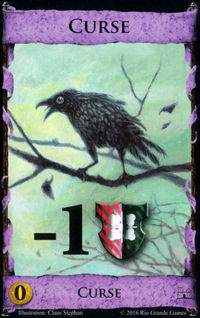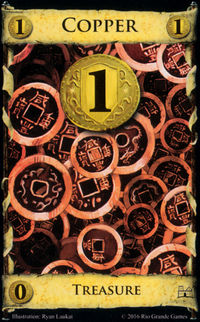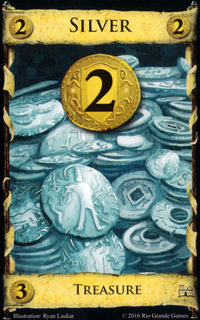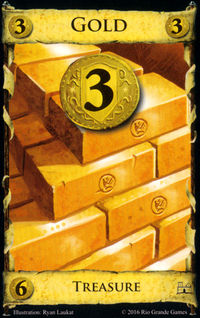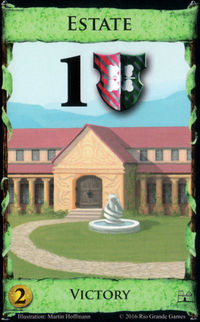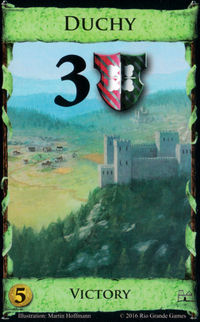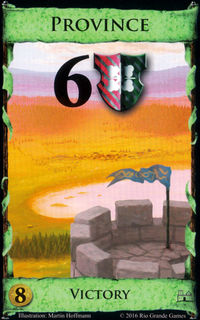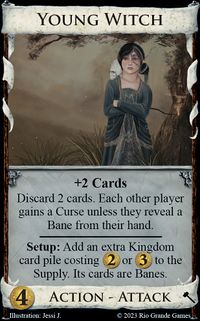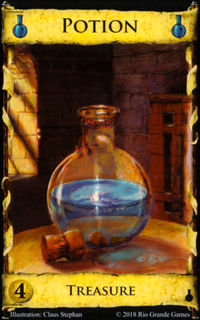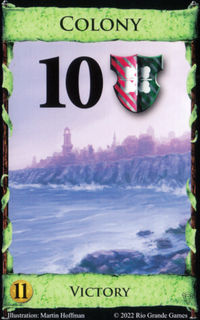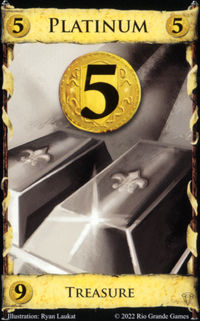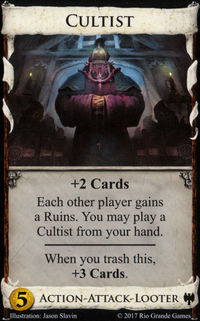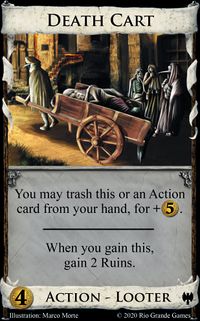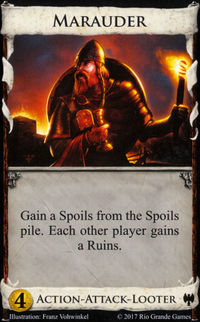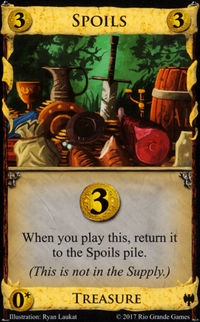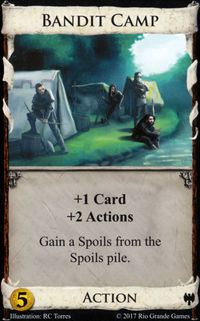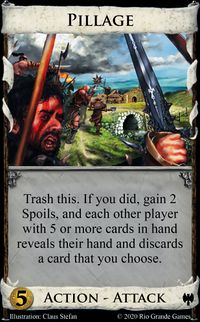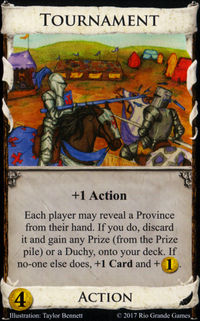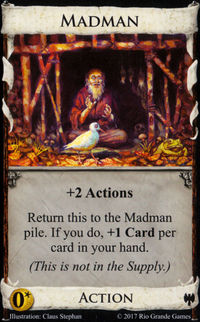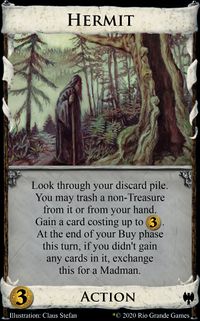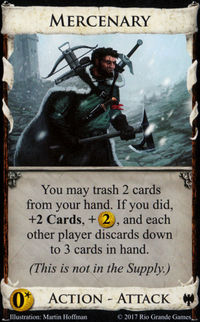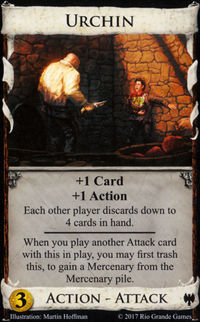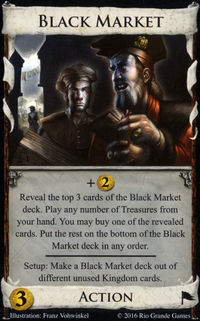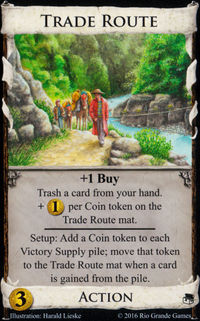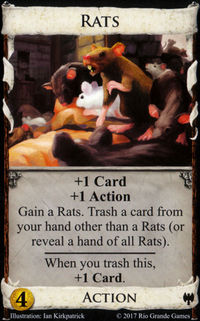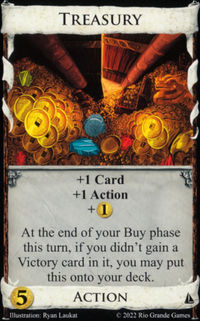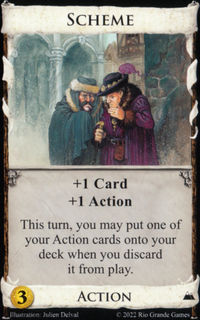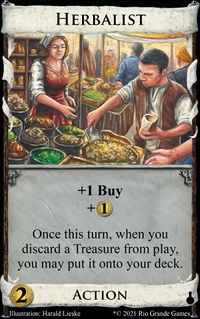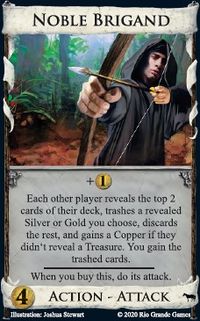Gameplay
m (Tiedy up Coin/Potion/Card-Template and internal links, lists and headlines) |
m (Tiedy up Coin/Potion/Card-Template and internal links, lists and headlines) |
||
| Line 12: | Line 12: | ||
Some Kingdom cards, if selected for a game, may involve the addition of other piles of cards that are not considered part of the Supply. For example: | Some Kingdom cards, if selected for a game, may involve the addition of other piles of cards that are not considered part of the Supply. For example: | ||
* {{Card|Spoils}} are included whenever one of {{Card|Bandit Camp}}, {{Card|Marauder}}, or {{Card|Pillage}} is in the Kingdom. | * {{Card|Spoils}} are included whenever one of {{Card|Bandit Camp}}, {{Card|Marauder}}, or {{Card|Pillage}} is in the Kingdom. | ||
| − | * [[Prize]] | + | * [[Prize|Prizes]] are used with {{Card|Tournament}}, {{Card|Madman}} is used with {{Card|Hermit}}, and {{Card|Mercenary}} is used with {{Card|Urchin}}. These additional cards are not considered part of the Supply and thus do not count towards the game ending condition. |
* A Black Market deck is used when playing with the [[Promo|promotional card]] {{Card|Black Market}}. | * A Black Market deck is used when playing with the [[Promo|promotional card]] {{Card|Black Market}}. | ||
| Line 28: | Line 28: | ||
== Phases == | == Phases == | ||
=== Action phase === | === Action phase === | ||
| − | In the Action phase, the player may play one [[Action card]]. Action cards are the cards that say ''Action'' at the bottom of the card. Since (in the absence of [[Shelter]] | + | In the Action phase, the player may play one [[Action card]]. Action cards are the cards that say ''Action'' at the bottom of the card. Since (in the absence of [[Shelter|Shelters]]) players do not start the game with any Action cards in their initial Decks of 10 cards, a player will usually not have any Actions to play during his first 2 turns. Normally, a player may play only one Action card, but this number may be modified by the Action cards that the player plays. It is never mandatory to play an Action card even if you have one in hand; the only exception is when another Action card that you have played instructs you to do so. |
To play an Action, the player takes an Action card from his hand and lays it face-up in his [[play area]]. He announces which card he is playing and follows the instructions written on that card from top to bottom. The player may still play an Action card even if he is not able to do everything the Action card tells him to do; but the player must do as much as he can. Furthermore, the player must fully resolve an Action card before playing another one (if he is able to play another Action card). Detailed information about card abilities can be found on other pages of this site. Any Action cards played remain in the player’s play area until the Clean-up phase of the turn unless otherwise indicated on the card. The Action phase ends when the player cannot or chooses not to play any more Action cards. Generally, a player can only play Action cards during the Action phase of his turn. | To play an Action, the player takes an Action card from his hand and lays it face-up in his [[play area]]. He announces which card he is playing and follows the instructions written on that card from top to bottom. The player may still play an Action card even if he is not able to do everything the Action card tells him to do; but the player must do as much as he can. Furthermore, the player must fully resolve an Action card before playing another one (if he is able to play another Action card). Detailed information about card abilities can be found on other pages of this site. Any Action cards played remain in the player’s play area until the Clean-up phase of the turn unless otherwise indicated on the card. The Action phase ends when the player cannot or chooses not to play any more Action cards. Generally, a player can only play Action cards during the Action phase of his turn. | ||
Revision as of 06:24, 25 April 2015
This article summarizes the rules of the game of Dominion.
Interpretation and exploitation of the rules and mechanics of the game entail strategy and tactics.
Contents |
Setup
To set up the game, first prepare the cards which constitute the Supply. The Supply normally consists of the 7 basic Supply piles (Curse, Copper, Silver, Gold, Estate, Duchy, and Province) and 10 Kingdom cards. (Curse cards are included even if no Kingdom card specifically references them.) The 10 Kingdom cards, collectively known as the Kingdom, may be chosen by any method agreed upon by the players. A common method is to select randomly from the Randomizer deck. Alternatively there are some Recommended Kingdoms that introduce the game and expansions or create interesting decisions for players. Certain Kingdom cards will require additional piles to be included in the Supply. Additional piles which may be included are:
- If Young Witch is selected as a Kingdom card, an 11th Kingdom card costing or , designated the Bane card, is added to the kingdom.
- Potion is used whenever any Kingdom card has in its cost.
- The use of Colony and Platinum may be added in games using Kingdom cards from Prosperity; it is recommended that this be decided randomly based on the percentage of Prosperity cards in the Kingdom. (See the Prosperity additional rules for more information.)
- Ruins are used whenever a card with the type Looter is included in the Kingdom. Specifically, Cultist, Death Cart, and Marauder constitute the Looters.
Some Kingdom cards, if selected for a game, may involve the addition of other piles of cards that are not considered part of the Supply. For example:
- Spoils are included whenever one of Bandit Camp, Marauder, or Pillage is in the Kingdom.
- Prizes are used with Tournament, Madman is used with Hermit, and Mercenary is used with Urchin. These additional cards are not considered part of the Supply and thus do not count towards the game ending condition.
- A Black Market deck is used when playing with the promotional card Black Market.
Moreover, some Kingdom cards include additional setup instructions. For example, Trade Route calls for the placement of tokens on Victory card Supply piles.
Each pile of Kingdom cards in the Supply normally contain 10 cards. Some exceptions include:
- The Rats pile (if in the Kingdom) contains 20 cards.
- Victory card piles contain 8 cards in a two-player game and 12 cards in games with more players. (A Kingdom card which is both a Victory card and another type is considered a Victory card.)
- The Province pile contains 15 cards for a five-player game and 18 cards for a six-player game.
- The Curse and Ruins piles contain 10 cards per player after the first.
- The basic Treasure card piles include as many copies of the card as are available in the game box.
Finally, mark out the trash pile (typically with the trash card), and give each player a starting Deck consisting of 7 Coppers and 3 Estates. If playing with Dark Ages, each player's starting Estates may be replaced with Shelter cards. (See the additional rules for Dark Ages for more information.) Players do not take their starting Estates from the Supply.
Phases
Action phase
In the Action phase, the player may play one Action card. Action cards are the cards that say Action at the bottom of the card. Since (in the absence of Shelters) players do not start the game with any Action cards in their initial Decks of 10 cards, a player will usually not have any Actions to play during his first 2 turns. Normally, a player may play only one Action card, but this number may be modified by the Action cards that the player plays. It is never mandatory to play an Action card even if you have one in hand; the only exception is when another Action card that you have played instructs you to do so.
To play an Action, the player takes an Action card from his hand and lays it face-up in his play area. He announces which card he is playing and follows the instructions written on that card from top to bottom. The player may still play an Action card even if he is not able to do everything the Action card tells him to do; but the player must do as much as he can. Furthermore, the player must fully resolve an Action card before playing another one (if he is able to play another Action card). Detailed information about card abilities can be found on other pages of this site. Any Action cards played remain in the player’s play area until the Clean-up phase of the turn unless otherwise indicated on the card. The Action phase ends when the player cannot or chooses not to play any more Action cards. Generally, a player can only play Action cards during the Action phase of his turn.
Buy phase
In the Buy phase, the player can gain one card from the Supply by paying its cost. Any card that is in the Supply may be purchased (Treasure, Victory, Kingdom, and even Curse or Ruins cards). The player may not purchase cards from the Trash pile or non-Supply piles. Normally, a player may buy only one card, but he may buy more if he played certain cards which grant +Buy either in the Action phase or at the beginning of the Buy phase.
The cost of a card is in its lower left corner. The player may play some or all of the Treasure cards from his hand in any order to his play area and add to their value the coins provided by Action cards played this turn. The player may then gain any card in the Supply of equal or lesser value. If the player has multiple Buys, he combines Treasure cards and any coins available from Action cards to pay for all of the purchases. He takes the purchased cards from its Supply pile and places it face-up on his Discard pile. He may not use the ability of the card when it is gained. Players do not have to use any or all of their Buys.
Clean-up phase
All cards gained this turn should already be in the player’s Discard pile. The player places any cards that are in his play area (Action cards that have been played in the Action phase as well as Treasure cards that have been played in the Buy phase) and any cards remaining in his hand onto his Discard pile. Although the player need not show the cards remaining in his hand to his opponents, since he places the cards in the Discard pile face-up, his opponents will always be able to see the top-most card of his Discard pile.
Then, the player draws a new hand of 5 cards from his Deck. If there are not enough cards in his Deck, he draws as many as he can, shuffles his Discard pile to form a new face-down Deck, and then draws the rest of his new hand. Once the player has drawn a new hand of 5 cards, the next player starts his turn. To speed play, players may begin their turns while previous players are completing their Clean-up phases. When someone plays an Attack card, the players must complete their Clean-up phases in order to properly resolve the Attack.
Certain cards have rules which supersede the rules presented here. Duration cards remain in play until the turn when they stop doing something. Other cards, such as Treasury, Scheme, and Herbalist allow you to place cards on top of your Deck before you discard them from play. Some of Noble Brigand's ability is used when it is bought.
Ending conditions
The game ends at the end of any player’s turn when any of these are true:
- Any three Supply piles are empty (four Supply piles in a game of at least five players)
- The Province Supply pile is empty
- The Colony Supply pile is empty (if Colony was used)
Scoring
Each player puts all of his cards into his Deck and counts the victory points on all the cards he has. The player with the most victory points wins. If the highest scores are tied at the end of the game, the tied player who has had the fewest turns wins the game. If the tied players have had the same number of turns, they rejoice in their shared victory.
Additional rules
Colony and Platinum
Colony and Platinum are always used together and the easiest way to determine if they are used is by randomly drawing one Randomizer from those used with each particular Kingdom. If the Randomizer card drawn is from Prosperity, include Colony and Platinum.
Shelters
One of each differently named card with type Shelter replace the three starting Estates in each deck if Dark Ages Kingdom cards are in the Supply. Similarly to Colony and Platinum from Prosperity, a draw from the Kingdom's Randomizers can determine whether Shelters are used.
Game zones
While the rules do not talk about zones as such, they are clearly established and an understanding of how they work can clear up confusion, especially for new players. Many events in the game can be conceptualized as a card or multiple cards being moved from one zone to another, with different zones having different properties.
This framework also aides in conceiving Dominion as a set of discrete instructions, such as would be used by computer programs.
For each player, the following zones exist:
- The player's hand
- The player's Deck
- The player's Discard pile
- The player's play area
- The player's revealed cards zone
Additionally, for all players, the following communal zones exist:
- The Trash pile
- Each Supply pile (including basic card piles and Kingdom card piles)
- Any non-Supply piles (in addition to the Trash)
Finally, several card abilities create more or less temporary zones, most often by instructing the player to set aside certain cards (sometimes only while an ability is resolved, other times indefinitely; cards which set aside cards will tell the player how to return set aside cards to one of the permanent zones). This zone is occasionally informally referred to as set-aside-cards-land.
